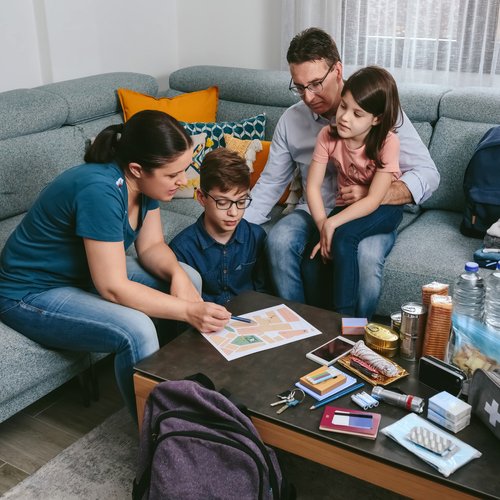15 Essential Items to Include in an Emergency Survival Kit
You can’t predict the future—or control the toll that a fire, hurricane, or flood takes on your home. But you can take steps to ensure that you’re prepared in the event you get stuck in your house after a natural disaster strikes. When it comes to being prepared, having insurance is crucial, and relatively affordable. But to be fully prepared for a natural disaster, you also need an emergency kit.
A useful emergency kit has more than just flashlights and some bottled water (although you should have those things, too). Your kit should contain supplies that will last you at least three days. And you should start cobbling it together now, so you aren’t caught off guard in the event of a crisis. It’s easy to lose focus on what you need to do in a disaster; having an emergency kit will allow you to focus on other tasks while knowing that you have the best emergency supplies handily packed in a kit. Make sure all household members know where the kit is stored. And, since your emergency kit might be the only thing you can take with you when you eventually leave the home, keep everything in an easy-to-carry container.
As for what should go inside the kit, follow this comprehensive checklist. (Heads up: Because some items can expire—and your family’s needs can change over time—look at your emergency kit at least once a year and make any necessary updates.)
Prescription Medications
If you have multiple prescriptions, make sure each is in a labeled bottled.
First-aid Kit
In addition to basic bandages, gauze, and antiseptic wipes, your first-aid kit should include an antihistamine, antacid, anti-inflammatory, pain reliever, fever reducer, antibiotic ointment, eyewash solution, instant cold compress, and hydrocortisone cream.
Flashlight and Battery-powered Radio
Don’t forget extra batteries!
Bottled Water
Lauritzen recommends 1 gallon of water per person per day. Sports drinks like Gatorade or Powerade are also good for replenishing electrolytes.
Food
Purchase nonperishable, easy-to-prepare snacks and meals with high protein (e.g., dried fruit, peanut butter, beef jerky, power bars, granola bars, canned vegetables, nuts, and canned tuna). These foods work well if the power goes out and you’re unable to cook or heat your food. (Don’t forget the can opener!)
Important Paperwork
Make sure you have at least two sets of any important documents—one at home that you can grab quickly if needed, and another in digital form that you keep stored in the cloud. The deed to your house, Social Security cards, medical records, and passports are just some of the paperwork you don’t want to forget.
Pet Supplies
Pack food and water, as well as a collar, leash, carrier, crate, and bowls.
Sleeping bags
Buy one sleeping bag per person, and pack additional bedding, such as warm blankets, if you live in a cold-weather climate.
Activities for Children
Keep the kids entertained (and distracted from the situation at hand) with coloring books, board games, a deck of cards, and puzzles.
Hygiene Products
This includes toothbrush, toothpaste, soap, feminine products, body-cleansing wipes, hand sanitizer, toilet paper, and tissue packs.
Cell Phone Charger
If you’re lucky, your home won’t lose power. But you might forget to grab your regular cellphone charger if you’re in a rush.
Candles and Matches
Keep the matches in a waterproof container.
Change of Clothing
Pack three days’ worth of clothes for each person and include sturdy shoes.
Special Items for Infants or the Elderly
Baby formula and food are obviously a must, but older family members—particularly those who have physical challenges—might need additional supplies.
Cash
If there’s a widespread power outage, stores won’t be able to run their card machines, and banks and ATMs won’t be operating. You’ll want some cash on hand if you need to buy necessary items or put gas in your car to leave town. How much cash you should stow away depends on the size of your family, how well-stocked you are, and your comfort level. Some experts recommend three to five days’ worth of spending money, while others suggest $1,000 to $2,000. In the end, whatever you’re comfortable socking away could save you in an emergency.




Leave a Reply